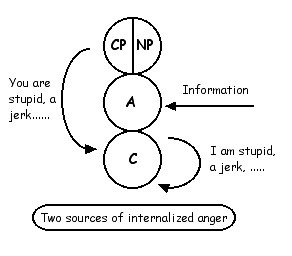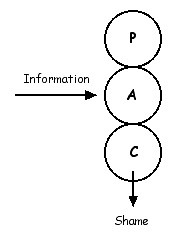However shame is different. Unlike sadness and anger, shame tears at the very sense of who we are in a way that other feelings do not. With shame one experiences a sense of painful self diminution. Their sense of worth, importance and sense of who they are as a person is painfully reduced. With shame there is a sense of ‘I am bad’. What does a therapist do with this?
When people feel shame there is a strong desire to withdraw or change the topic. The person wants to go into hiding in some way. This seems to be the natural Free Child reaction to shame. The problem with this, is it does not deal with it, in the therapeutic sense.

Now that's embarrassing!
In essence it is an avoidant, ‘Lets try and forget about it’, approach. This works with small ‘traumas’ but with big ones it does not work. They need to be brought out into the open, experienced and then one can ‘get over it’. The Free Child reaction with shame is to hide and avoid. With most other feelings the Free Child reaction is a therapeutic one that will bring resolution of the painful event like expressing sad feelings when one’s cat dies. With shame the natural Free Child reaction will not bring resolution or closure to the event. Thus shame is somewhat unique in this way.
I will cite how I have developed my approach to shame over the years.
The first step is to clarify the shame, the guilt and the internally directed anger. As I have shown before these can be articulated by three separate transactional diagrams:



These three transactions can coexist in various combinations at the one time and often do. The therapist needs to assist the client to untangle them. Sometimes when a client initially reports a feeling of shame one finds there is not a shame reaction but it maybe a guilt reaction or internal anger reaction.
One indicator that shame is present the client’s unwillingness to bring it up and discuss it. If there is a true shame reaction the client may be quite unwilling to mention it which is a problem in itself because the therapist may not hear about it for some time. Obviously if the therapist does not know about it then it cannot be dealt with. Examples of this can be self harm or bulimia. The shame that is felt about these activities may result in the client not mentioning it for some time.
However when the client does raise the shaming event the therapist knows this is a positive move indeed. It means the client now experiences the therapeutic relationship in such a way that she is prepared to raise such a sensitive and intimate issue. The therapist is now being trusted in way that he has not been before.

When this happens the therapist untangles the three possible reactions of inward anger, guilt and shame. The therapist then deals with the inward anger and guilt in the usual therapeutic ways. Whilst doing this the stage is being set for the shame to be dealt with.
The client is then asked to do something that is unnatural for them to do. With shame the Free Child wants to hide and withdraw but the therapist asks the client to come out into public (with the therapist) and talk about the shame and the shaming event.
This to my mind, is the first step to resolving the shame. As simple and unsophisticated as it is. The shame is simply brought out into the relational with the therapist and the therapist responds in an empathetic fashion. Once the shaming event has been disclosed the therapist can bring it out into the open at the appropriate time. This requires some caution such that one does not reshame the client in the therapy setting.
From what I have seen once the event and shame have been discussed a number of times it seems to loose its potency. The catharsis obtained from speaking about it with the therapist seems to reduce the need to hide it. Subsequently it can be raised much more easily by either party when need be.

Thus the initial therapy process is to come out of hiding, speak about the event and the feelings with another trusted person. If that person responds favourably the shame and embarrassment diminish over time.
However this is not the end of the story. Whilst it may be easier to discuss it with the therapist, the underlying damage that resulted from the shaming event still remains. With guilt one has the sensation of ‘I am bad because I did x’. With shame it is simply, ‘I am bad’.
This is treated with the usual various redecisions, awareness of the shame, acceptance of shame as a natural thing, hypnotic suggestions when the client is significantly regressed, working through the negative and positive transference reactions, forgiveness of self and so forth. This takes time depending on the depth of ‘badness’ the client experiences. However this process is significantly helped if the shaming event looses it impact in the ways I have described above such that the event can be more easily spoken about. The need to hide with the shame fades and diminishes.
Graffiti
Timely post Tony. I'm talking a lot about shame right now. I know you didn't imply it is easy, but your comment about bringing it out, dealing with it and "get over it" made me wish it was that simple. Well - it may be that simple, but the process can take a long time.
ReplyDeleteTake care,
OLJ
Hello OLJ,
ReplyDeleteMaybe i didn't imply it but maybe i was a bit cavalier with my comments. And you sort of predicited my response with your last sentence. I usually in circumstances highlight the distiction between simple and difficult. Some thing can be quite simple to do but very emotionally difficult to do. I would say that some of therapy is like that as you note.
Indeed I would say a good deal of human communication is like that. It is quite simple for one person to say to another, I love you, or I am angry at you. But some would find this very difficult to say at the same time.
Take care
Tony
Hi Tony -
ReplyDeleteDidn't set the response to subscribe so just seeing this response. I think shame is an emotionally difficult thing to deal with, even in therapy. It's funny - it's taken a couple of years in therapy to realize that shame is probably the most difficult thing to deal with. I wasn't even aware that I had a lot of shame about my past - but it's definitely surfacing.
Take care,
OLJ
Hi OLJ,
ReplyDeleteGood to hear you are becoming aware of past feelings even though they may not feel so good. I agree with you that shame is a difficult emotion to deal with therapeutically.
Regards
Tony
this has helped me in my studies so thank you very much
ReplyDeleteYou are welcome Allison X
ReplyDeleteTony